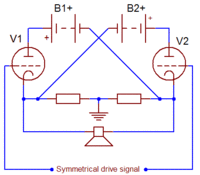- Circlotron
-
Circlotron valve amplifier is a type of power amplifier utilizing symmetrical cathode-coupled bridge layout of the output stage. Original circlotrons of 1950s used output transformers to couple relatively high output impedance of vacuum tubes to low-impedance loudspeakers. Circlotron architecture, easily scalable, was eventually adapted to operate without output transformers, and present-day commercially produced circlotron models are of output transformerless (OTL) type.
Contents
History
Circlotron name emerged as a trademark of Electro-Voice. A U.S. patent for a circlotron High Fidelity Audio Amplifier was filed by Alpha Wiggins of Electro-Voice on March 1, 1954 and granted March 28, 1958.[1]. However, other inventors filed the same concept earlier:[2]
- C. T. Hall filed Parallel Opposed Power Amplifiers on June 7, 1951; U.S. Patent 2,705,265 granted on March 29, 1955.
- Tapio Köykkä filed on September 2, 1952; Finnish Patent 27332 granted on November 10, 1954; improved version was filed on September 30, 1955, Finnish Patent 29642 granted on April 10, 1958.
All these patents called for a transformer-coupled, fully balanced design; commercial transformerless amplifiers were not feasible at this time due to high costs of power supply capacitors required for an OTL design (at least thousands of microfarads at 200 volts or better). In 1950s and 1960s circlotrons were produced by Electro-Voice (8 models, 15 to 100 watts per channel), Finnish Voima and Philips.[2] These inspired other local manufacturers, such as Carad. All these models employed output transformers and beam tetrode or pentode tubes (for increased efficiency). Similar amateur designs were published in the USSR.
The concept was resurrected in its transformerless form in early 1980s by Ralph Karsten, founder of Atma-Sphere which remains the principal contemporary manufacturer of circlotrons. Other OTL circlotrons are made by Tenor Audio and Korean manufacturers.
Basic transformerless schematic
 Simplified diagram (omitting grid bias network)
Simplified diagram (omitting grid bias network)
The electrical bridge of a circlotron is formed by a matched pair of triodes (V1, V2) and two floating power supplies ('B batteries'), B1+ and B2+. Grids of each triode are driven in opposite phases with a balanced, symmetrical input signal; differential current flows through the loudspeaker load and a simple, relatively high impedance, resistor network that ties floating supplies to the ground. Tubes are usually fixed biased with an external negative power supply ('C battery'); each side normally has independent bias adjustment to compensate for minor tube mismatch.
Output impedance Z of a transformerless circlotron where each stage is a single triode with plate impedance of Rp and voltage gain of μ is defined by the formula
- Z = Rp / (2 + μ)[3]
The tubes best fitting the circlotron concept belong to the regulator pass-through type: 6AS7, 6C33C, 6C19P. An amplifier with one 6AS7 dual triode per channel (Rp = 600 ohms[4], μ = 2) will have a Z of 150 ohms—sufficient to drive high-impedance headphones. Driving loudspeakers requires paralleling output tubes, and in practice, V1 and V2 are not single triodes, but massive banks of paralleled triodes. Simple OTL amplifiers, for example Atma-Sphere M-60, employ 8 double triodes of 6AS7 type per channel; each continuously dissipates an average of 30 watts. Without feedback, this arrangement results in an output impedance of 6–8 ohms. It can be further lowered by applying global negative feedback or paralleling more output tubes. On the extreme end, Atma-Sphere MA-2 amplifier uses 20 6AS7 tubes per channel, with a continuous power consumption of 600 watts per channel (800 watts at maximum rated output of 220 watts, or a 27% maximum efficiency).
Benefits and drawbacks
Perceived fidelity (quality) of audio reproduction is a hardly quantifiable, subjective measure that should be left to each individual listener's taste. Apart from audio fidelity, circlotron OTL have certain benefits versus asymmetrical OTLs (i.e. Futterman amplifier) and conventional, transformer-coupled amplifiers:
- Scalability. The same basic design can be easily scaled up or down by adding (removing) output tubes.
- Loudspeaker safety. Even when either V1 or V2 bank fails completely, direct current through speaker is limited to non-destructive values.
- Reliability. Failure in one triode (or a double-triode tube) can be offset by re-biasing the amplifier; it will continue operating, although at reduced maximum output and with increased even-order distortion caused by output stage asymmetry.
- Linear frequency response and fast transient handling. Absence of output transformer and global negative feedback extends full power frequency response into hundreds of kilohertz. On the lower end of frequency scale, bass response is limited by power supply capacity and driver circuit, and can be easily extended below 1 hertz.
All these benefits can be negated by power consumption: minimal stereo power amplifier (Atma-Sphere S-30) continuously burns 400 watts, while practical low-impedance stereo setups approach 1 kilowatt. Apart from ethical considerations and costs of electricity, such heat sources bring discomfort to listening room and may require dedicated ventilation and air conditioning.
Circlotrons, unlike minimalistic single-ended amplifiers, need to employ quite complex balanced input and driver stages delivering at least 100V peak-to-peak voltage and able to drive relatively high capacitance loads (due to the number of paralleled power triodes and lengthy wiring). The first requirement is typically solved with a long-tailed cascode stage (2 or 3 double triodes), the second - with two cathode followers inserted between the driver stage and the power stage. Both need a bipolar power supply, independent of the power stage power supplies, and firing up well in advance of the power stage supply.
References
- ^ U.S. Patent 2,828,369
- ^ a b circlotron.tripod.com
- ^ See a comparison of OTL topologies and their output impedances Tube Lovers Anonymous
- ^ Actual Rp in a paralleled setting may be even higher due to conservative biasing
External links
Categories:- Audio amplifiers
- Valve amplifiers
Wikimedia Foundation. 2010.
